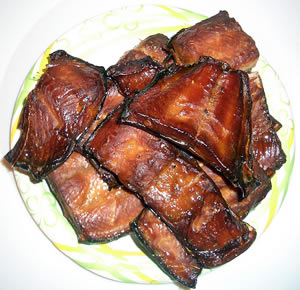
Modern-style smoked salmon: a staple on many Alaskan tables. Photo courtesy of Wikimedia Commons.
At one time obtaining fish was central to the Tlingits winter survival. Salmon was the chief part of their diet, but also important were halibut, eulachon and herring. They lavished great care on the development of fishing equipment and techniques, which proved superior to those imported by the first Europeans. Only one innovation was readily adopted by Tlingit fishermen: the replacement of bone and stone points with iron.
Various traditional means were used by the Tlingit people for catching and using locally abundant fish. Fishing was considered men’s work. Women prepared the catch.
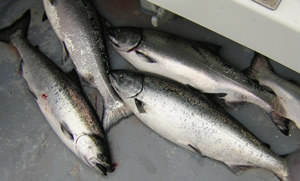
Silver salmon on the deck of a boat. Photo courtesy Grantley Moore.
Salmon
Five species of salmon return to spawn in local water in late spring, summer and early fall. Additionally, a late run of chum salmon swim up the Chilkat River in November, giving rise to a large gathering of Bald Eagles and other predators and scavengers who take advantage of the plentiful food source during lean winters months.
“>
The Tlingit people preserved salmon to sustain themselves over the bitter winters. Salmon were usually dried (flesh side-out) on a framework out of doors if protected from the elements, or in a special smokehouse. Once dried, fish were stacked, tied in bundles and often stored in bentwood boxes for later use. When the winter supply had been set aside, the remaining salmon were rendered into oil.
There were various methods for catching salmon:
-
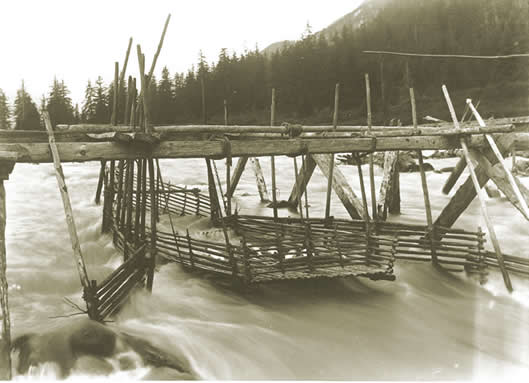
A Tlingit fish trap built across the Chilkoot River, 1894.Fish Trap
- The fish trap, the most common method used for catching salmon, was quite simple in theory. One variety was a wooden fence stretched across a stream or river, preferably at rapids. Salmon swimming upstream passed through the openings and into specially woven baskets placed there by the fishermen. Another trap consisted of rows of posts placed closely together across a stream. These posts hampered the salmon on their upstream journey and allowed fishermen to spear them from wooden platforms.
-
Salmon Spear
- Used in conjunction with the fish trap or when fishing from a canoe, the salmon spear was an 11′ to 16′ shaft topped with a barbed iron [originally bone] point attached with a leather thong. When a salmon was struck with a spear, the point detached itself from the shaft, allowing the fish to thrash without breaking the spear shaft.
-
Salmon Hook
- The salmon hook was commonly used from the shore, on a platform in the river, or a canoe in shallow water. It was a long pole with an iron hook pulled through the water using a raking motion. Obviously, it was most successful in streams congested with salmon.
-
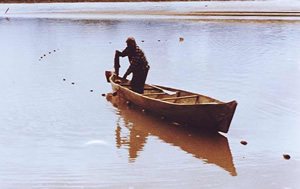
A fisherman brings in a salmon caught in his gillnet probably set in the Chilkat River.Gill Net
- The gill net, another traditional method for catching salmon, is very widley used today. A net with mesh designed to trap the fish by its gills was hung vertically across a stream or stretch of water like a curtain.
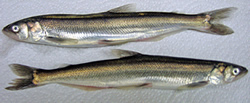
Eulachon, also known as candlefish. A small smelt-like fish that grows to about 11 inches long. Photo courtesy of Wikimedia Commons.
Eulachon
Also called candlefish and often misprounounced “hooligan,” this small member of the smelt family has always been prized by the Tlingit people. Rendered into mineral and vitamin rich oil, it was used for seasoning, preserving and trade, and prevented many illnesses caused my such deficiencies common in other native communities.
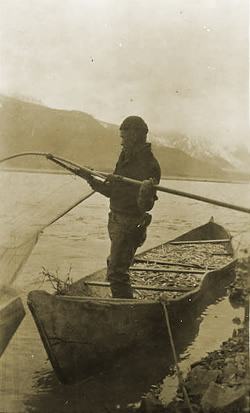
Ben Watson netting eulachon, 1927. The canoe is filled almost to overflowing with eulachon.
Eulachon run up both the Chilkat and Chilkoot rivers in vast black schools. Due to their large numbers and habit of hugging the shoreline, they were easily scooped up in fine-mesh dip nets of sinew made by the women. With the introduction of iron, a rakewas designed for gathering eulachon. A long pole with iron spikes was propelled through the water like a sculling oar. It impaled the eulachon which were then thrown into the boat. Fish traps, similar to those used for catching salmon but with a smaller mesh, were also employed in eulachon fishing.
To render the oil, the fish were allowed to ripen 10-14 days in a canoe half buried in sand. The canoe was then filled with water and scalding stones heated in a nearby fire. As the steaming mixture was stirred, oil rose to the top and was skimmed with large spoons. Residue was further pressed through woven baskets to reclaim all the precious oil. A container or pit later replaced the canoe and a fire or stove, the hot stones, but the general process remains the same to this day.
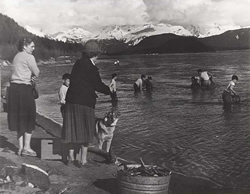 Haines House kids dip-netting for eulachon in the Chilkat River, 1953-1957.
|
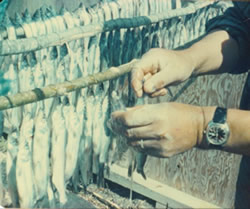 Jeff David preparing eulachon for drying, spring 1975.
|
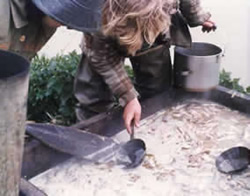 Oil being skimmed off heated eulachon.
Some say the oil has the best flavor (it won’t taste “fishy”)
if the eulachon never boils, circa 1979.
|
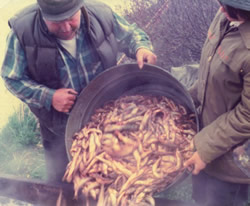 Jerry and daughter, Lani Strong, empty “ripened” eulachon
into vats filled with hot water to render the oil, circa 1979.
|
So highly prized was this clear oil that it became an important trade item with Athabascan Indians in the Interior. Trade trails from the coast inland became known as “grease trails.”
Eulachon were also eaten fresh, dried or smoked and dried fish were widely used as smokey candles because of their high fat content.
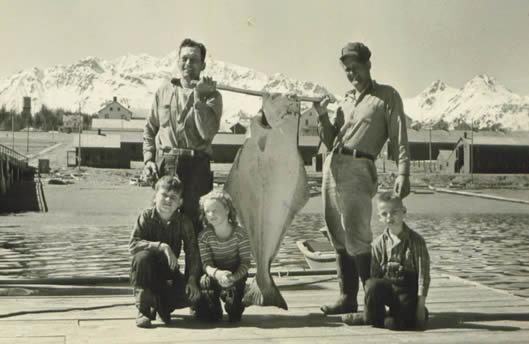
Paul Karluk and Karl Tagg on the Fort Seward dock showing off a large halibut, pre-1950s.
Halibut
Halibut can reach gigantic proportions in local waters, sometimes reaching six feet in length and weighing over 400 pounds. To insure a manageable size catch, Tlingit fisherman devised a special halibut hook which would only be taken by a 30-50 pound fish. A large fish could sink a canoe or severly injure the fisherman. Moreover, this medium range halibut was considered superior for drying.
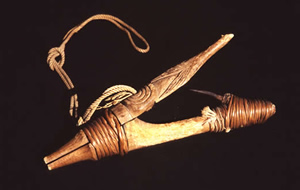
A halibut hook used by the Tlingits for catching the “perfect” sized halibut — between 30-50 pounds.
The wooden halibut hook was a V-shaped affair with an obliquely set iron nail. The wood was usually carved with symbolic figures, often heraldic or associated with the Shaman, such as the skeleton, devilfish or land otter.
Hooks were usually baited with fish and lowered with a line of red cedar fiber, braided sinew or the strong stem of a giant kelp.
Stone sinkers carried the line to the bottom and wooden floats carved in animal forms alerted the fishermen to a bite. The entire assembly was kept afloat with inflated bladders, allowing the fisherman to set several lines at once. Halibut were consumed fresh or dried.

Pacific Herring, which grow up to 18 inches long. Photo courtesy of Wikimedia Commons.
Herring
Herring, especially their eggs, have long been considered a delicacy by the Tlingits. In April and May great schools of herring made their way into shallow bays. Herring were often caught with the same rake used to catch eulachon. They were dried or eaten fresh.
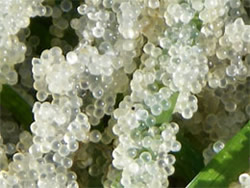
Herring eggs on sea grass. Photo courtesy of Wikimedia Commons.
Herring eggs, still gathered in the traditional manner, were caught on hemlock boughs laid on a known spawning beach during a low tide. The boughs, tied to the shore, were collected after the fish deposited their eggs. Eggs were dried or mixed with fat and stored for winter use.
Barbara Waterbury, 1987
updated by Blythe Carter, 2013
Bibliography:
Billman, Esther. Tlingit Bulletin. Vol. 1. Sitka: Sheldon Jackson Museum Press, 1975.
Jonaitis, Aldona. Art of the Northern Tlingit, Seattle; University of Washington Press, 1986.
Krause, Aurel. The Tlingit Indians. Translator: Gunther, Erna, 1956. Seattle: University of Washington Press, 1885.


